University Assignment: ITC 560 - IOT in Smart City Literature Review
VerifiedAdded on 2023/06/04
|10
|2313
|155
Report
AI Summary
This report, prepared by a student, delves into the realm of Internet of Things (IOT) applications within smart cities. It begins with a comprehensive literature review, analyzing various research papers and articles to provide a broad understanding of the current state of IOT technologies in urban environments. The review covers diverse aspects, including short-range communication, machine learning algorithms, environmental considerations, digital technologies, wireless sensor networks, and the integration of IOT in daily city life. Following the literature review, an annotated bibliography is presented, offering concise summaries and evaluations of key research papers. The report further outlines the project requirements, addressing challenges, protocols, compatibility, privacy issues, and the effectiveness of IOT systems. It also explores problem-solving approaches and examines current and past techniques used to address challenges related to the implementation of IOT in smart cities. The document offers valuable insights into the design, implementation, and functions of IOT-enabled smart city solutions.
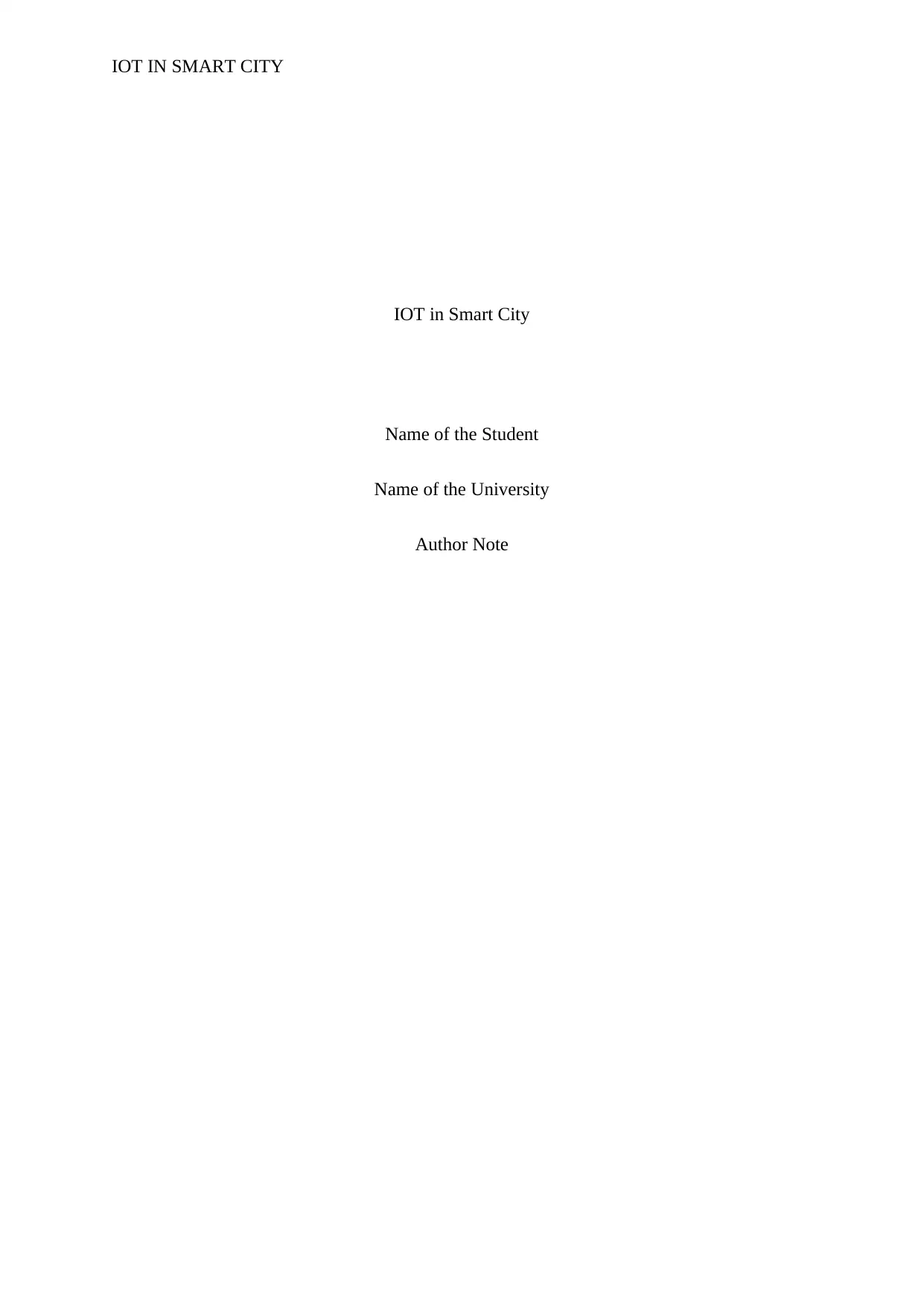
IOT IN SMART CITY
IOT in Smart City
Name of the Student
Name of the University
Author Note
IOT in Smart City
Name of the Student
Name of the University
Author Note
Paraphrase This Document
Need a fresh take? Get an instant paraphrase of this document with our AI Paraphraser
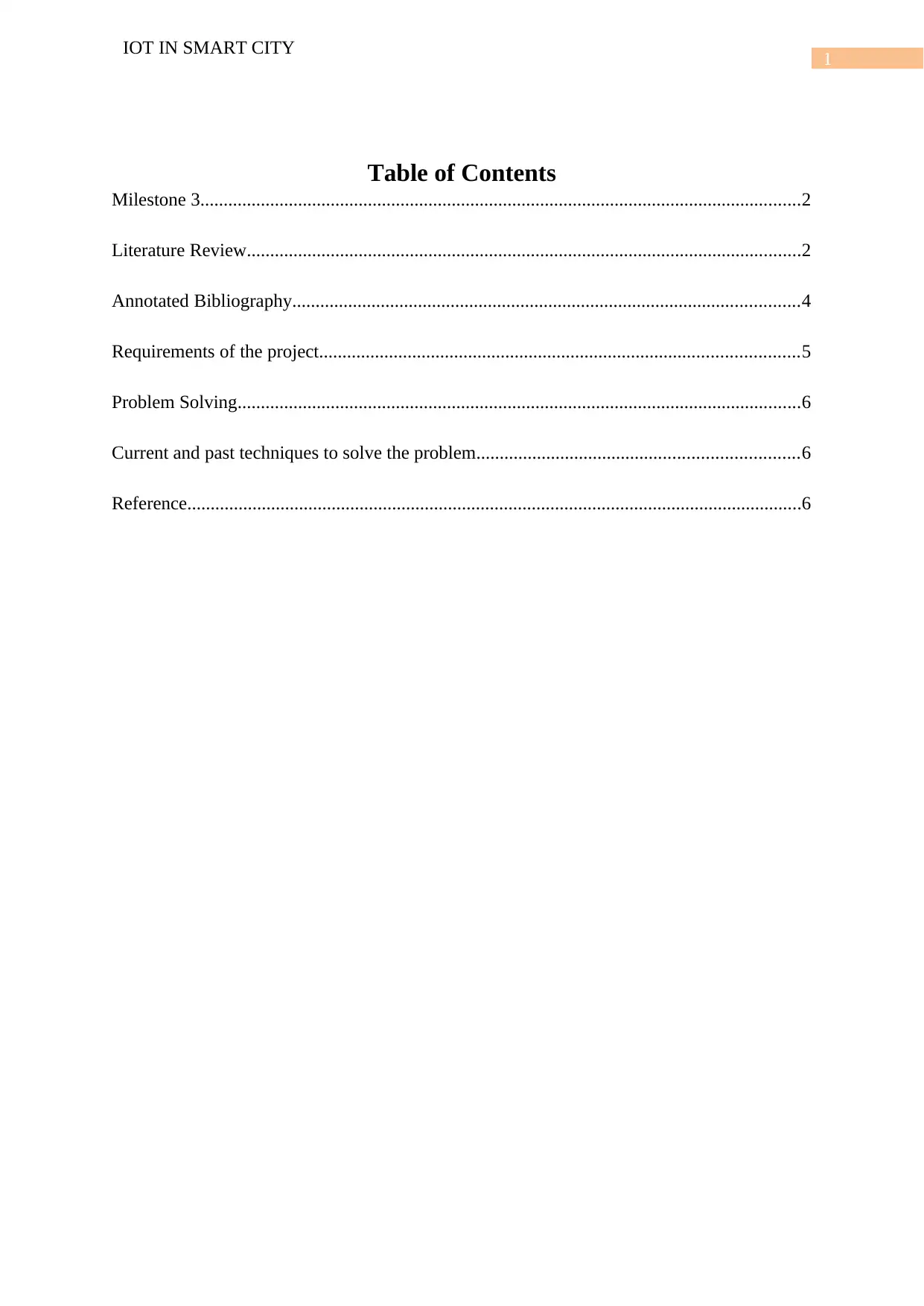
1
IOT IN SMART CITY
Table of Contents
Milestone 3.................................................................................................................................2
Literature Review.......................................................................................................................2
Annotated Bibliography.............................................................................................................4
Requirements of the project.......................................................................................................5
Problem Solving.........................................................................................................................6
Current and past techniques to solve the problem.....................................................................6
Reference....................................................................................................................................6
IOT IN SMART CITY
Table of Contents
Milestone 3.................................................................................................................................2
Literature Review.......................................................................................................................2
Annotated Bibliography.............................................................................................................4
Requirements of the project.......................................................................................................5
Problem Solving.........................................................................................................................6
Current and past techniques to solve the problem.....................................................................6
Reference....................................................................................................................................6
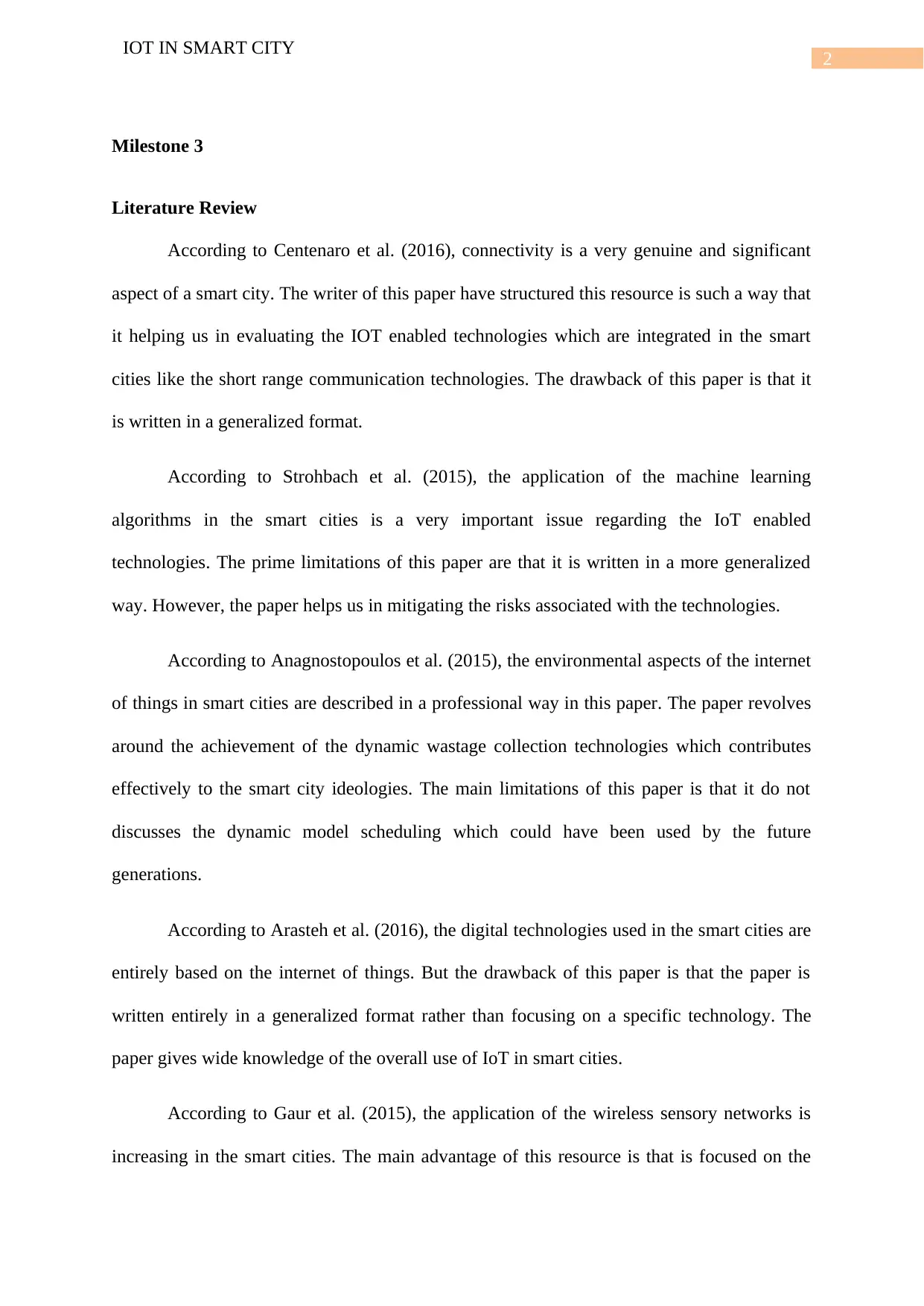
2
IOT IN SMART CITY
Milestone 3
Literature Review
According to Centenaro et al. (2016), connectivity is a very genuine and significant
aspect of a smart city. The writer of this paper have structured this resource is such a way that
it helping us in evaluating the IOT enabled technologies which are integrated in the smart
cities like the short range communication technologies. The drawback of this paper is that it
is written in a generalized format.
According to Strohbach et al. (2015), the application of the machine learning
algorithms in the smart cities is a very important issue regarding the IoT enabled
technologies. The prime limitations of this paper are that it is written in a more generalized
way. However, the paper helps us in mitigating the risks associated with the technologies.
According to Anagnostopoulos et al. (2015), the environmental aspects of the internet
of things in smart cities are described in a professional way in this paper. The paper revolves
around the achievement of the dynamic wastage collection technologies which contributes
effectively to the smart city ideologies. The main limitations of this paper is that it do not
discusses the dynamic model scheduling which could have been used by the future
generations.
According to Arasteh et al. (2016), the digital technologies used in the smart cities are
entirely based on the internet of things. But the drawback of this paper is that the paper is
written entirely in a generalized format rather than focusing on a specific technology. The
paper gives wide knowledge of the overall use of IoT in smart cities.
According to Gaur et al. (2015), the application of the wireless sensory networks is
increasing in the smart cities. The main advantage of this resource is that is focused on the
IOT IN SMART CITY
Milestone 3
Literature Review
According to Centenaro et al. (2016), connectivity is a very genuine and significant
aspect of a smart city. The writer of this paper have structured this resource is such a way that
it helping us in evaluating the IOT enabled technologies which are integrated in the smart
cities like the short range communication technologies. The drawback of this paper is that it
is written in a generalized format.
According to Strohbach et al. (2015), the application of the machine learning
algorithms in the smart cities is a very important issue regarding the IoT enabled
technologies. The prime limitations of this paper are that it is written in a more generalized
way. However, the paper helps us in mitigating the risks associated with the technologies.
According to Anagnostopoulos et al. (2015), the environmental aspects of the internet
of things in smart cities are described in a professional way in this paper. The paper revolves
around the achievement of the dynamic wastage collection technologies which contributes
effectively to the smart city ideologies. The main limitations of this paper is that it do not
discusses the dynamic model scheduling which could have been used by the future
generations.
According to Arasteh et al. (2016), the digital technologies used in the smart cities are
entirely based on the internet of things. But the drawback of this paper is that the paper is
written entirely in a generalized format rather than focusing on a specific technology. The
paper gives wide knowledge of the overall use of IoT in smart cities.
According to Gaur et al. (2015), the application of the wireless sensory networks is
increasing in the smart cities. The main advantage of this resource is that is focused on the
⊘ This is a preview!⊘
Do you want full access?
Subscribe today to unlock all pages.

Trusted by 1+ million students worldwide
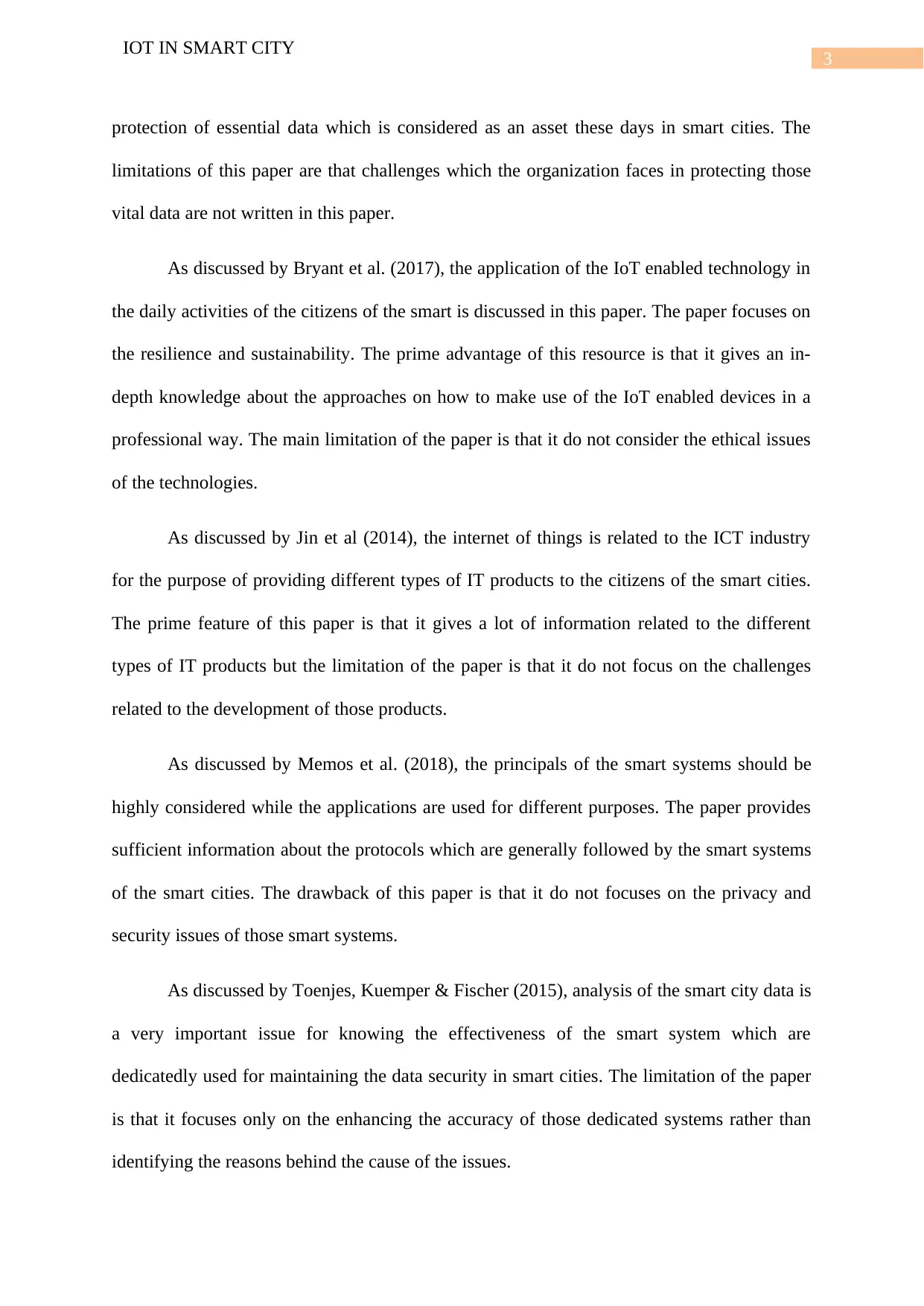
3
IOT IN SMART CITY
protection of essential data which is considered as an asset these days in smart cities. The
limitations of this paper are that challenges which the organization faces in protecting those
vital data are not written in this paper.
As discussed by Bryant et al. (2017), the application of the IoT enabled technology in
the daily activities of the citizens of the smart is discussed in this paper. The paper focuses on
the resilience and sustainability. The prime advantage of this resource is that it gives an in-
depth knowledge about the approaches on how to make use of the IoT enabled devices in a
professional way. The main limitation of the paper is that it do not consider the ethical issues
of the technologies.
As discussed by Jin et al (2014), the internet of things is related to the ICT industry
for the purpose of providing different types of IT products to the citizens of the smart cities.
The prime feature of this paper is that it gives a lot of information related to the different
types of IT products but the limitation of the paper is that it do not focus on the challenges
related to the development of those products.
As discussed by Memos et al. (2018), the principals of the smart systems should be
highly considered while the applications are used for different purposes. The paper provides
sufficient information about the protocols which are generally followed by the smart systems
of the smart cities. The drawback of this paper is that it do not focuses on the privacy and
security issues of those smart systems.
As discussed by Toenjes, Kuemper & Fischer (2015), analysis of the smart city data is
a very important issue for knowing the effectiveness of the smart system which are
dedicatedly used for maintaining the data security in smart cities. The limitation of the paper
is that it focuses only on the enhancing the accuracy of those dedicated systems rather than
identifying the reasons behind the cause of the issues.
IOT IN SMART CITY
protection of essential data which is considered as an asset these days in smart cities. The
limitations of this paper are that challenges which the organization faces in protecting those
vital data are not written in this paper.
As discussed by Bryant et al. (2017), the application of the IoT enabled technology in
the daily activities of the citizens of the smart is discussed in this paper. The paper focuses on
the resilience and sustainability. The prime advantage of this resource is that it gives an in-
depth knowledge about the approaches on how to make use of the IoT enabled devices in a
professional way. The main limitation of the paper is that it do not consider the ethical issues
of the technologies.
As discussed by Jin et al (2014), the internet of things is related to the ICT industry
for the purpose of providing different types of IT products to the citizens of the smart cities.
The prime feature of this paper is that it gives a lot of information related to the different
types of IT products but the limitation of the paper is that it do not focus on the challenges
related to the development of those products.
As discussed by Memos et al. (2018), the principals of the smart systems should be
highly considered while the applications are used for different purposes. The paper provides
sufficient information about the protocols which are generally followed by the smart systems
of the smart cities. The drawback of this paper is that it do not focuses on the privacy and
security issues of those smart systems.
As discussed by Toenjes, Kuemper & Fischer (2015), analysis of the smart city data is
a very important issue for knowing the effectiveness of the smart system which are
dedicatedly used for maintaining the data security in smart cities. The limitation of the paper
is that it focuses only on the enhancing the accuracy of those dedicated systems rather than
identifying the reasons behind the cause of the issues.
Paraphrase This Document
Need a fresh take? Get an instant paraphrase of this document with our AI Paraphraser
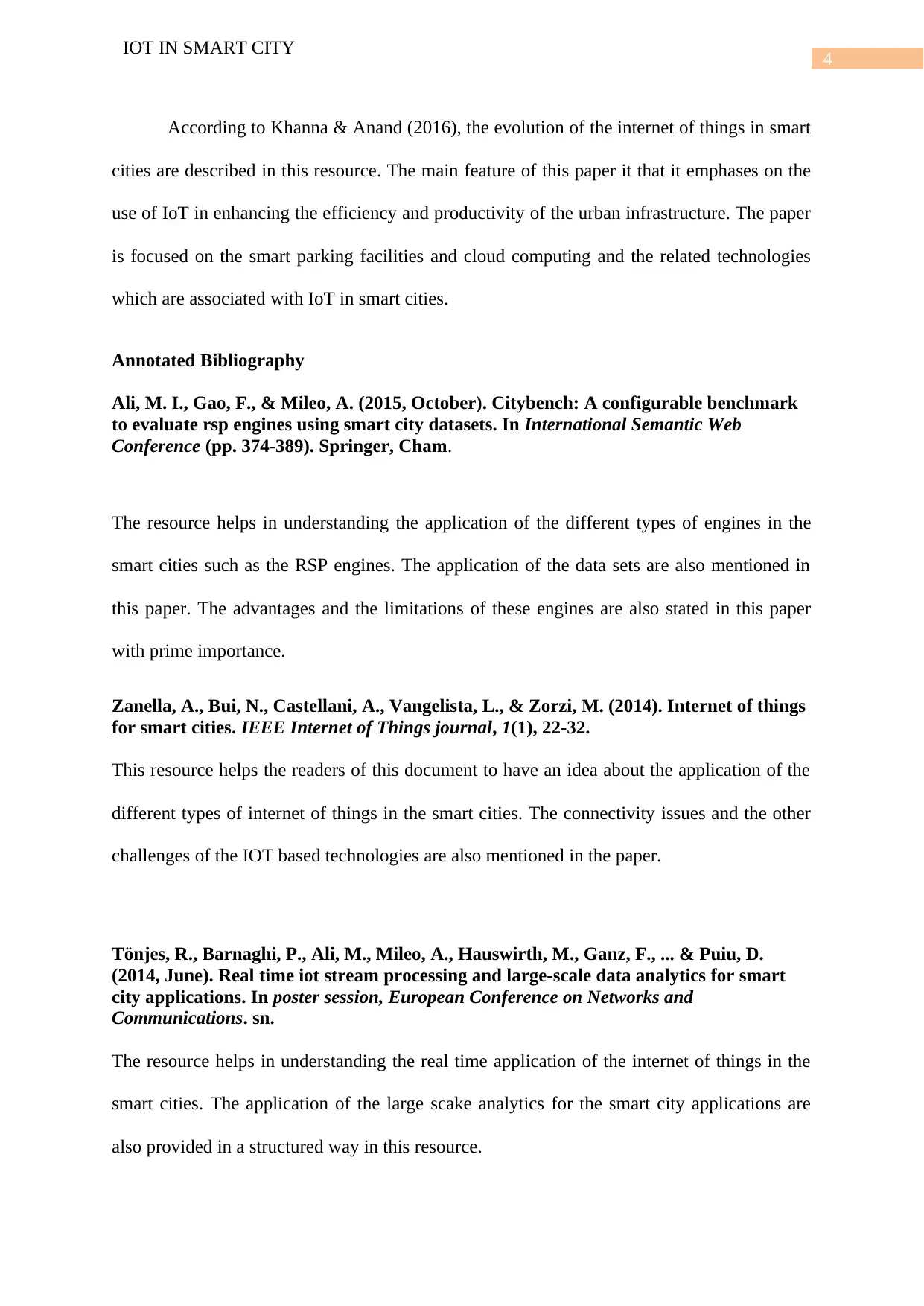
4
IOT IN SMART CITY
According to Khanna & Anand (2016), the evolution of the internet of things in smart
cities are described in this resource. The main feature of this paper it that it emphases on the
use of IoT in enhancing the efficiency and productivity of the urban infrastructure. The paper
is focused on the smart parking facilities and cloud computing and the related technologies
which are associated with IoT in smart cities.
Annotated Bibliography
Ali, M. I., Gao, F., & Mileo, A. (2015, October). Citybench: A configurable benchmark
to evaluate rsp engines using smart city datasets. In International Semantic Web
Conference (pp. 374-389). Springer, Cham.
The resource helps in understanding the application of the different types of engines in the
smart cities such as the RSP engines. The application of the data sets are also mentioned in
this paper. The advantages and the limitations of these engines are also stated in this paper
with prime importance.
Zanella, A., Bui, N., Castellani, A., Vangelista, L., & Zorzi, M. (2014). Internet of things
for smart cities. IEEE Internet of Things journal, 1(1), 22-32.
This resource helps the readers of this document to have an idea about the application of the
different types of internet of things in the smart cities. The connectivity issues and the other
challenges of the IOT based technologies are also mentioned in the paper.
Tönjes, R., Barnaghi, P., Ali, M., Mileo, A., Hauswirth, M., Ganz, F., ... & Puiu, D.
(2014, June). Real time iot stream processing and large-scale data analytics for smart
city applications. In poster session, European Conference on Networks and
Communications. sn.
The resource helps in understanding the real time application of the internet of things in the
smart cities. The application of the large scake analytics for the smart city applications are
also provided in a structured way in this resource.
IOT IN SMART CITY
According to Khanna & Anand (2016), the evolution of the internet of things in smart
cities are described in this resource. The main feature of this paper it that it emphases on the
use of IoT in enhancing the efficiency and productivity of the urban infrastructure. The paper
is focused on the smart parking facilities and cloud computing and the related technologies
which are associated with IoT in smart cities.
Annotated Bibliography
Ali, M. I., Gao, F., & Mileo, A. (2015, October). Citybench: A configurable benchmark
to evaluate rsp engines using smart city datasets. In International Semantic Web
Conference (pp. 374-389). Springer, Cham.
The resource helps in understanding the application of the different types of engines in the
smart cities such as the RSP engines. The application of the data sets are also mentioned in
this paper. The advantages and the limitations of these engines are also stated in this paper
with prime importance.
Zanella, A., Bui, N., Castellani, A., Vangelista, L., & Zorzi, M. (2014). Internet of things
for smart cities. IEEE Internet of Things journal, 1(1), 22-32.
This resource helps the readers of this document to have an idea about the application of the
different types of internet of things in the smart cities. The connectivity issues and the other
challenges of the IOT based technologies are also mentioned in the paper.
Tönjes, R., Barnaghi, P., Ali, M., Mileo, A., Hauswirth, M., Ganz, F., ... & Puiu, D.
(2014, June). Real time iot stream processing and large-scale data analytics for smart
city applications. In poster session, European Conference on Networks and
Communications. sn.
The resource helps in understanding the real time application of the internet of things in the
smart cities. The application of the large scake analytics for the smart city applications are
also provided in a structured way in this resource.
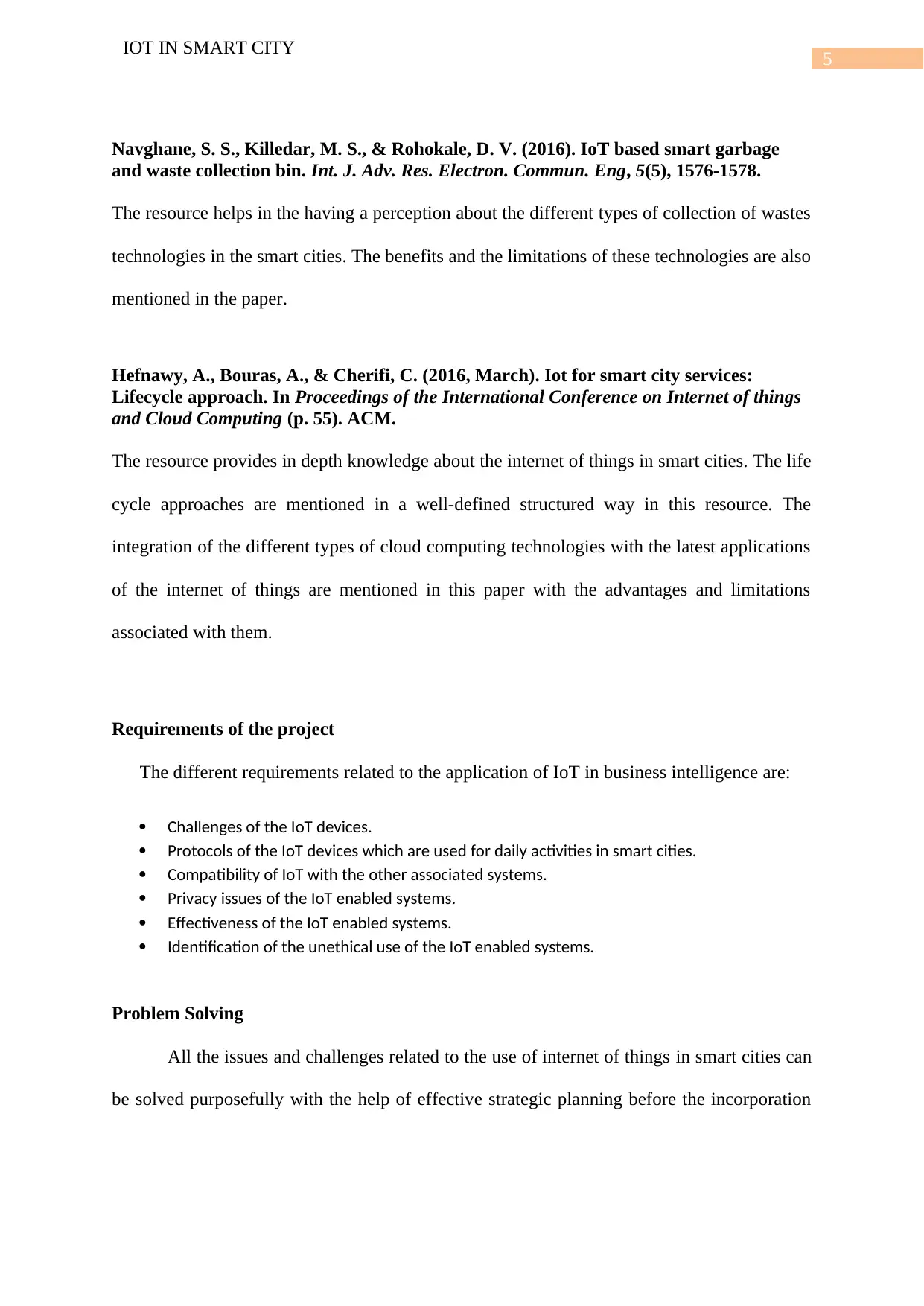
5
IOT IN SMART CITY
Navghane, S. S., Killedar, M. S., & Rohokale, D. V. (2016). IoT based smart garbage
and waste collection bin. Int. J. Adv. Res. Electron. Commun. Eng, 5(5), 1576-1578.
The resource helps in the having a perception about the different types of collection of wastes
technologies in the smart cities. The benefits and the limitations of these technologies are also
mentioned in the paper.
Hefnawy, A., Bouras, A., & Cherifi, C. (2016, March). Iot for smart city services:
Lifecycle approach. In Proceedings of the International Conference on Internet of things
and Cloud Computing (p. 55). ACM.
The resource provides in depth knowledge about the internet of things in smart cities. The life
cycle approaches are mentioned in a well-defined structured way in this resource. The
integration of the different types of cloud computing technologies with the latest applications
of the internet of things are mentioned in this paper with the advantages and limitations
associated with them.
Requirements of the project
The different requirements related to the application of IoT in business intelligence are:
Challenges of the IoT devices.
Protocols of the IoT devices which are used for daily activities in smart cities.
Compatibility of IoT with the other associated systems.
Privacy issues of the IoT enabled systems.
Effectiveness of the IoT enabled systems.
Identification of the unethical use of the IoT enabled systems.
Problem Solving
All the issues and challenges related to the use of internet of things in smart cities can
be solved purposefully with the help of effective strategic planning before the incorporation
IOT IN SMART CITY
Navghane, S. S., Killedar, M. S., & Rohokale, D. V. (2016). IoT based smart garbage
and waste collection bin. Int. J. Adv. Res. Electron. Commun. Eng, 5(5), 1576-1578.
The resource helps in the having a perception about the different types of collection of wastes
technologies in the smart cities. The benefits and the limitations of these technologies are also
mentioned in the paper.
Hefnawy, A., Bouras, A., & Cherifi, C. (2016, March). Iot for smart city services:
Lifecycle approach. In Proceedings of the International Conference on Internet of things
and Cloud Computing (p. 55). ACM.
The resource provides in depth knowledge about the internet of things in smart cities. The life
cycle approaches are mentioned in a well-defined structured way in this resource. The
integration of the different types of cloud computing technologies with the latest applications
of the internet of things are mentioned in this paper with the advantages and limitations
associated with them.
Requirements of the project
The different requirements related to the application of IoT in business intelligence are:
Challenges of the IoT devices.
Protocols of the IoT devices which are used for daily activities in smart cities.
Compatibility of IoT with the other associated systems.
Privacy issues of the IoT enabled systems.
Effectiveness of the IoT enabled systems.
Identification of the unethical use of the IoT enabled systems.
Problem Solving
All the issues and challenges related to the use of internet of things in smart cities can
be solved purposefully with the help of effective strategic planning before the incorporation
⊘ This is a preview!⊘
Do you want full access?
Subscribe today to unlock all pages.

Trusted by 1+ million students worldwide
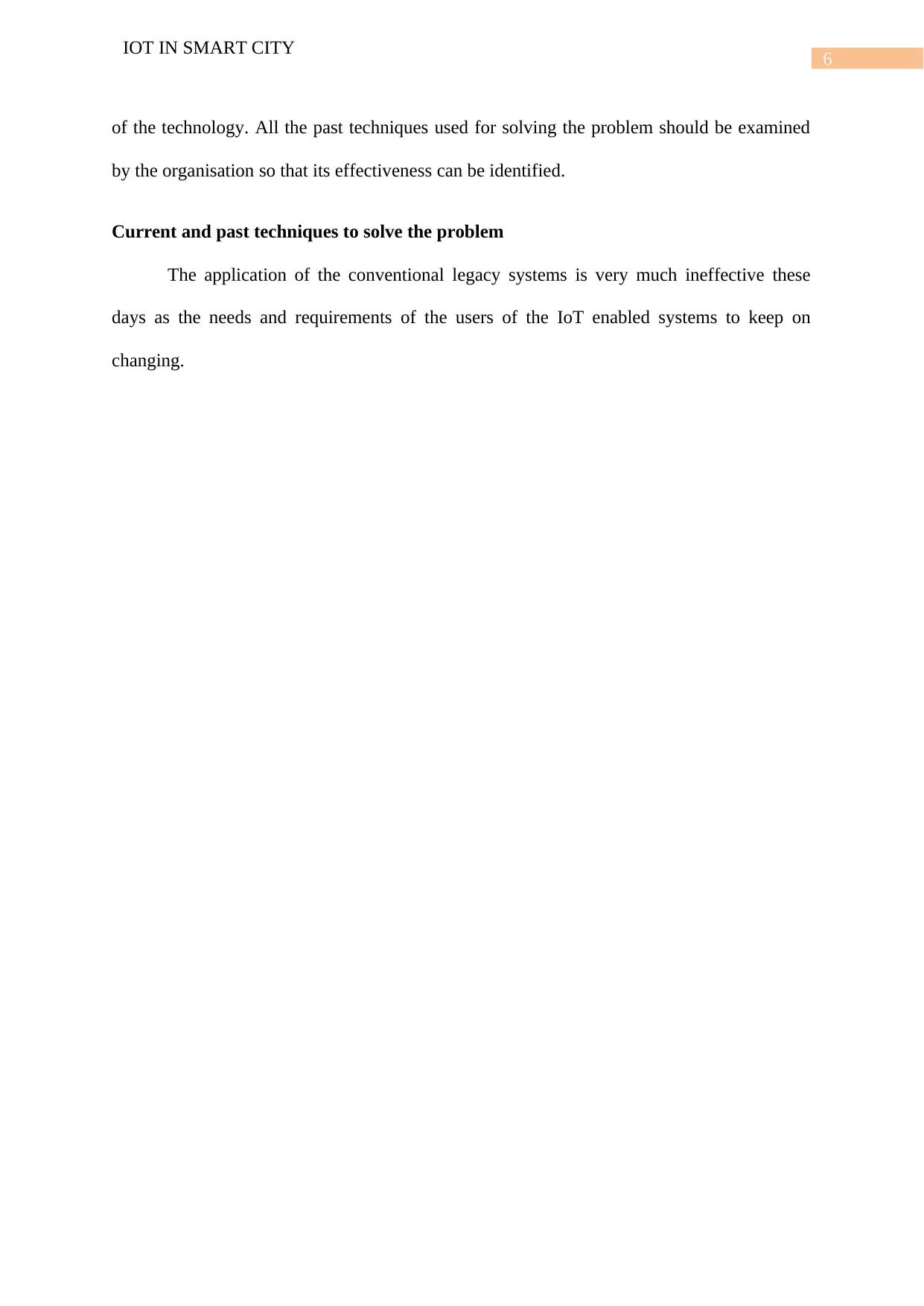
6
IOT IN SMART CITY
of the technology. All the past techniques used for solving the problem should be examined
by the organisation so that its effectiveness can be identified.
Current and past techniques to solve the problem
The application of the conventional legacy systems is very much ineffective these
days as the needs and requirements of the users of the IoT enabled systems to keep on
changing.
IOT IN SMART CITY
of the technology. All the past techniques used for solving the problem should be examined
by the organisation so that its effectiveness can be identified.
Current and past techniques to solve the problem
The application of the conventional legacy systems is very much ineffective these
days as the needs and requirements of the users of the IoT enabled systems to keep on
changing.
Paraphrase This Document
Need a fresh take? Get an instant paraphrase of this document with our AI Paraphraser
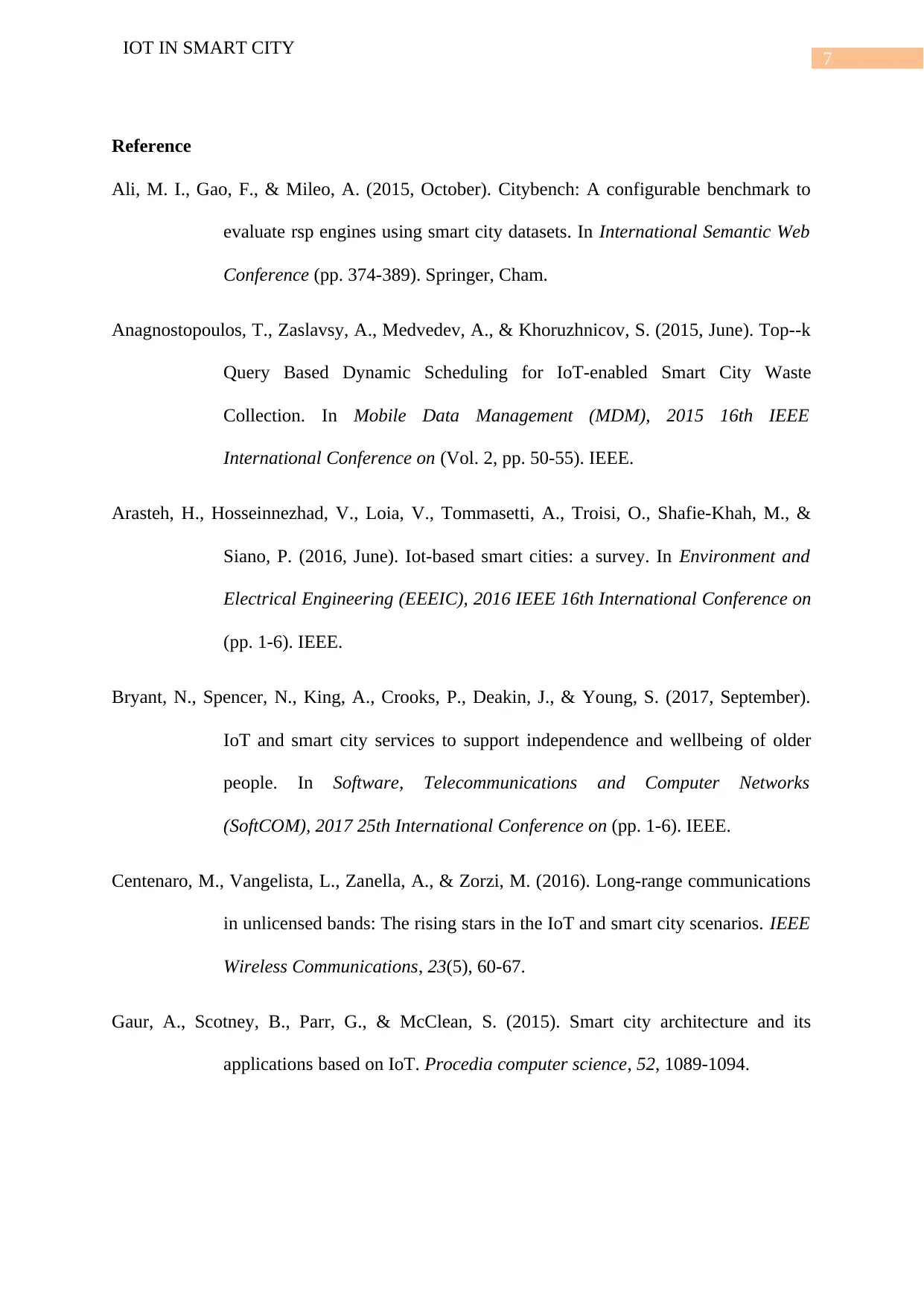
7
IOT IN SMART CITY
Reference
Ali, M. I., Gao, F., & Mileo, A. (2015, October). Citybench: A configurable benchmark to
evaluate rsp engines using smart city datasets. In International Semantic Web
Conference (pp. 374-389). Springer, Cham.
Anagnostopoulos, T., Zaslavsy, A., Medvedev, A., & Khoruzhnicov, S. (2015, June). Top--k
Query Based Dynamic Scheduling for IoT-enabled Smart City Waste
Collection. In Mobile Data Management (MDM), 2015 16th IEEE
International Conference on (Vol. 2, pp. 50-55). IEEE.
Arasteh, H., Hosseinnezhad, V., Loia, V., Tommasetti, A., Troisi, O., Shafie-Khah, M., &
Siano, P. (2016, June). Iot-based smart cities: a survey. In Environment and
Electrical Engineering (EEEIC), 2016 IEEE 16th International Conference on
(pp. 1-6). IEEE.
Bryant, N., Spencer, N., King, A., Crooks, P., Deakin, J., & Young, S. (2017, September).
IoT and smart city services to support independence and wellbeing of older
people. In Software, Telecommunications and Computer Networks
(SoftCOM), 2017 25th International Conference on (pp. 1-6). IEEE.
Centenaro, M., Vangelista, L., Zanella, A., & Zorzi, M. (2016). Long-range communications
in unlicensed bands: The rising stars in the IoT and smart city scenarios. IEEE
Wireless Communications, 23(5), 60-67.
Gaur, A., Scotney, B., Parr, G., & McClean, S. (2015). Smart city architecture and its
applications based on IoT. Procedia computer science, 52, 1089-1094.
IOT IN SMART CITY
Reference
Ali, M. I., Gao, F., & Mileo, A. (2015, October). Citybench: A configurable benchmark to
evaluate rsp engines using smart city datasets. In International Semantic Web
Conference (pp. 374-389). Springer, Cham.
Anagnostopoulos, T., Zaslavsy, A., Medvedev, A., & Khoruzhnicov, S. (2015, June). Top--k
Query Based Dynamic Scheduling for IoT-enabled Smart City Waste
Collection. In Mobile Data Management (MDM), 2015 16th IEEE
International Conference on (Vol. 2, pp. 50-55). IEEE.
Arasteh, H., Hosseinnezhad, V., Loia, V., Tommasetti, A., Troisi, O., Shafie-Khah, M., &
Siano, P. (2016, June). Iot-based smart cities: a survey. In Environment and
Electrical Engineering (EEEIC), 2016 IEEE 16th International Conference on
(pp. 1-6). IEEE.
Bryant, N., Spencer, N., King, A., Crooks, P., Deakin, J., & Young, S. (2017, September).
IoT and smart city services to support independence and wellbeing of older
people. In Software, Telecommunications and Computer Networks
(SoftCOM), 2017 25th International Conference on (pp. 1-6). IEEE.
Centenaro, M., Vangelista, L., Zanella, A., & Zorzi, M. (2016). Long-range communications
in unlicensed bands: The rising stars in the IoT and smart city scenarios. IEEE
Wireless Communications, 23(5), 60-67.
Gaur, A., Scotney, B., Parr, G., & McClean, S. (2015). Smart city architecture and its
applications based on IoT. Procedia computer science, 52, 1089-1094.
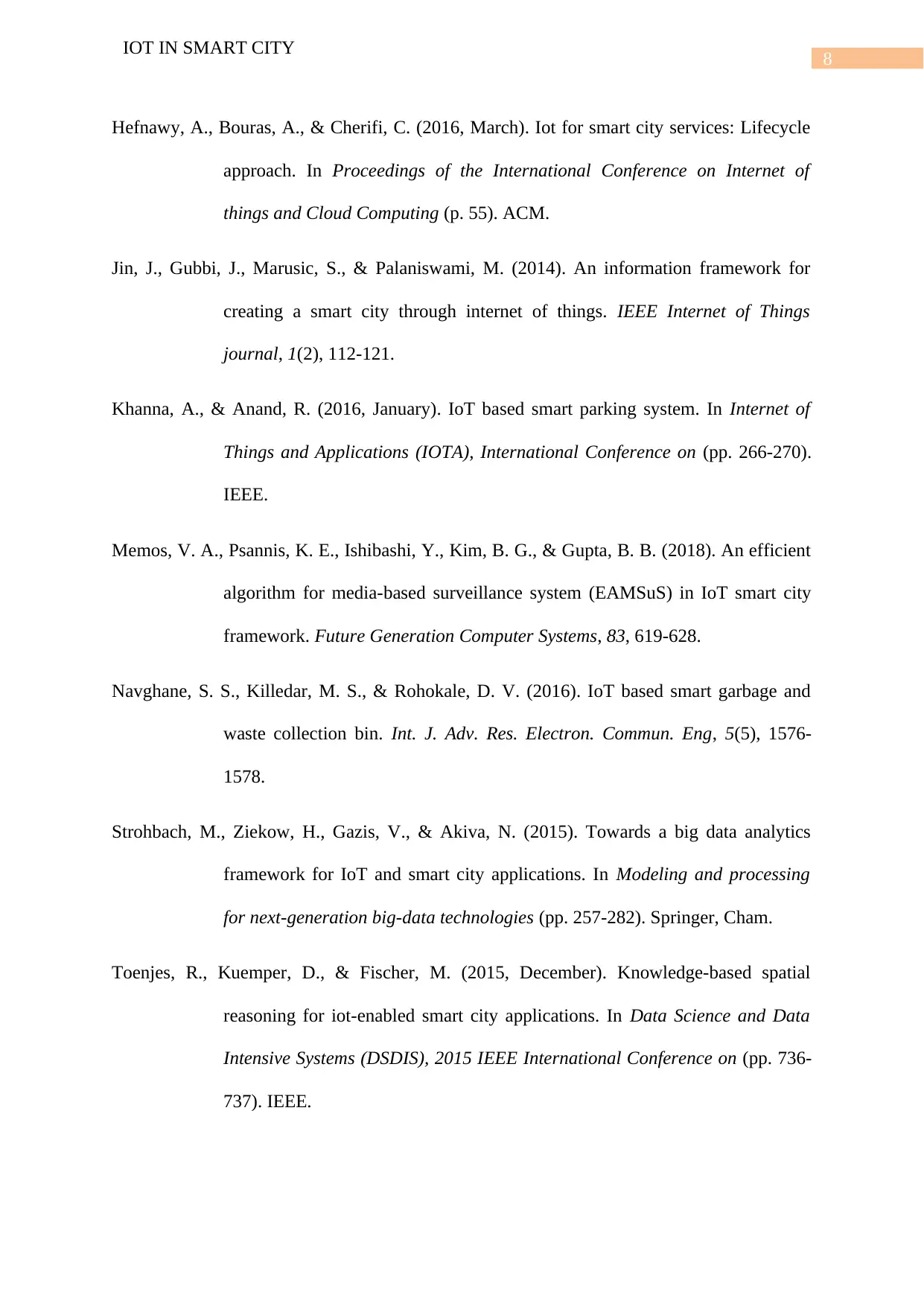
8
IOT IN SMART CITY
Hefnawy, A., Bouras, A., & Cherifi, C. (2016, March). Iot for smart city services: Lifecycle
approach. In Proceedings of the International Conference on Internet of
things and Cloud Computing (p. 55). ACM.
Jin, J., Gubbi, J., Marusic, S., & Palaniswami, M. (2014). An information framework for
creating a smart city through internet of things. IEEE Internet of Things
journal, 1(2), 112-121.
Khanna, A., & Anand, R. (2016, January). IoT based smart parking system. In Internet of
Things and Applications (IOTA), International Conference on (pp. 266-270).
IEEE.
Memos, V. A., Psannis, K. E., Ishibashi, Y., Kim, B. G., & Gupta, B. B. (2018). An efficient
algorithm for media-based surveillance system (EAMSuS) in IoT smart city
framework. Future Generation Computer Systems, 83, 619-628.
Navghane, S. S., Killedar, M. S., & Rohokale, D. V. (2016). IoT based smart garbage and
waste collection bin. Int. J. Adv. Res. Electron. Commun. Eng, 5(5), 1576-
1578.
Strohbach, M., Ziekow, H., Gazis, V., & Akiva, N. (2015). Towards a big data analytics
framework for IoT and smart city applications. In Modeling and processing
for next-generation big-data technologies (pp. 257-282). Springer, Cham.
Toenjes, R., Kuemper, D., & Fischer, M. (2015, December). Knowledge-based spatial
reasoning for iot-enabled smart city applications. In Data Science and Data
Intensive Systems (DSDIS), 2015 IEEE International Conference on (pp. 736-
737). IEEE.
IOT IN SMART CITY
Hefnawy, A., Bouras, A., & Cherifi, C. (2016, March). Iot for smart city services: Lifecycle
approach. In Proceedings of the International Conference on Internet of
things and Cloud Computing (p. 55). ACM.
Jin, J., Gubbi, J., Marusic, S., & Palaniswami, M. (2014). An information framework for
creating a smart city through internet of things. IEEE Internet of Things
journal, 1(2), 112-121.
Khanna, A., & Anand, R. (2016, January). IoT based smart parking system. In Internet of
Things and Applications (IOTA), International Conference on (pp. 266-270).
IEEE.
Memos, V. A., Psannis, K. E., Ishibashi, Y., Kim, B. G., & Gupta, B. B. (2018). An efficient
algorithm for media-based surveillance system (EAMSuS) in IoT smart city
framework. Future Generation Computer Systems, 83, 619-628.
Navghane, S. S., Killedar, M. S., & Rohokale, D. V. (2016). IoT based smart garbage and
waste collection bin. Int. J. Adv. Res. Electron. Commun. Eng, 5(5), 1576-
1578.
Strohbach, M., Ziekow, H., Gazis, V., & Akiva, N. (2015). Towards a big data analytics
framework for IoT and smart city applications. In Modeling and processing
for next-generation big-data technologies (pp. 257-282). Springer, Cham.
Toenjes, R., Kuemper, D., & Fischer, M. (2015, December). Knowledge-based spatial
reasoning for iot-enabled smart city applications. In Data Science and Data
Intensive Systems (DSDIS), 2015 IEEE International Conference on (pp. 736-
737). IEEE.
⊘ This is a preview!⊘
Do you want full access?
Subscribe today to unlock all pages.

Trusted by 1+ million students worldwide
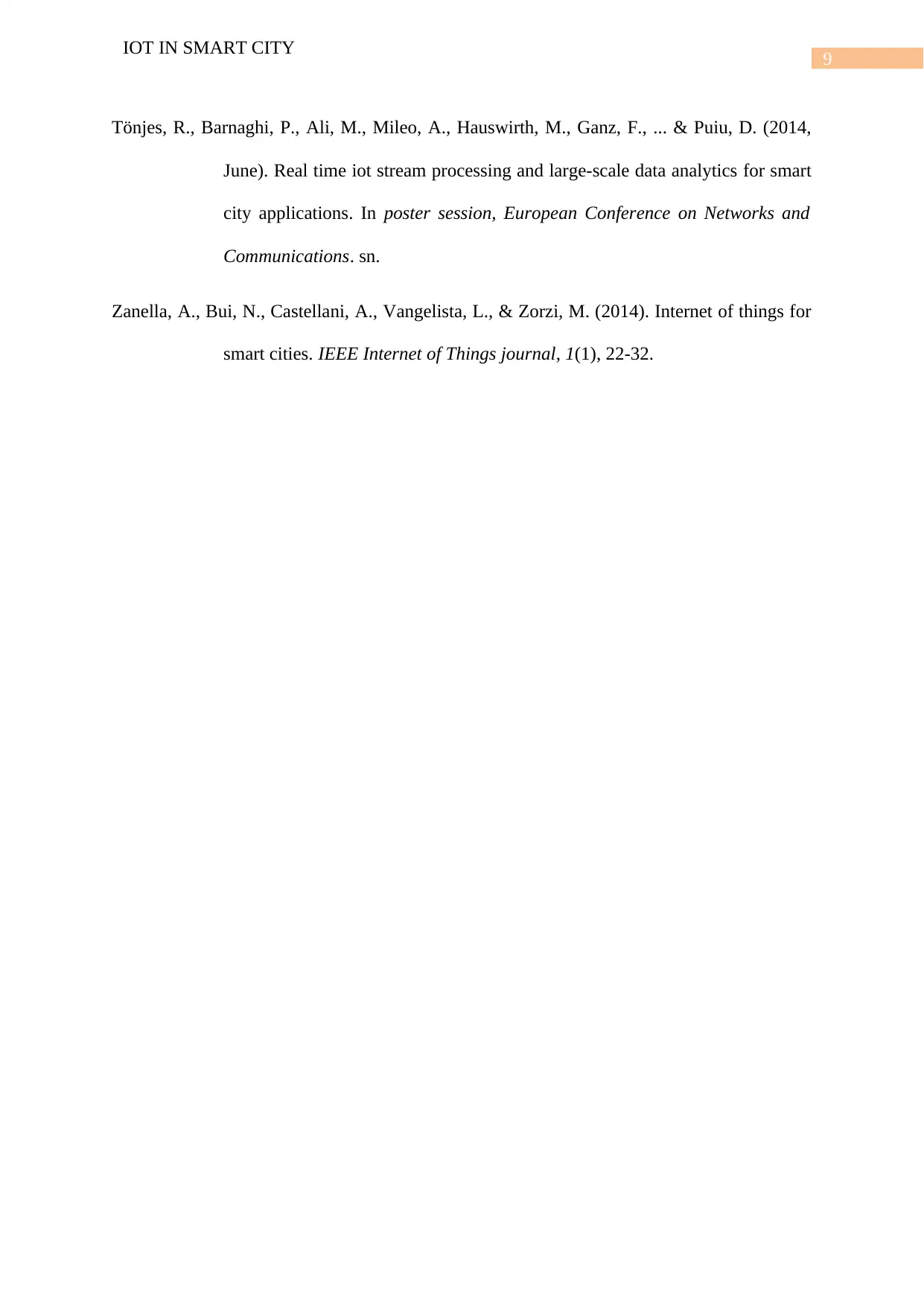
9
IOT IN SMART CITY
Tönjes, R., Barnaghi, P., Ali, M., Mileo, A., Hauswirth, M., Ganz, F., ... & Puiu, D. (2014,
June). Real time iot stream processing and large-scale data analytics for smart
city applications. In poster session, European Conference on Networks and
Communications. sn.
Zanella, A., Bui, N., Castellani, A., Vangelista, L., & Zorzi, M. (2014). Internet of things for
smart cities. IEEE Internet of Things journal, 1(1), 22-32.
IOT IN SMART CITY
Tönjes, R., Barnaghi, P., Ali, M., Mileo, A., Hauswirth, M., Ganz, F., ... & Puiu, D. (2014,
June). Real time iot stream processing and large-scale data analytics for smart
city applications. In poster session, European Conference on Networks and
Communications. sn.
Zanella, A., Bui, N., Castellani, A., Vangelista, L., & Zorzi, M. (2014). Internet of things for
smart cities. IEEE Internet of Things journal, 1(1), 22-32.
1 out of 10
Related Documents
Your All-in-One AI-Powered Toolkit for Academic Success.
+13062052269
info@desklib.com
Available 24*7 on WhatsApp / Email
![[object Object]](/_next/static/media/star-bottom.7253800d.svg)
Unlock your academic potential
Copyright © 2020–2025 A2Z Services. All Rights Reserved. Developed and managed by ZUCOL.




